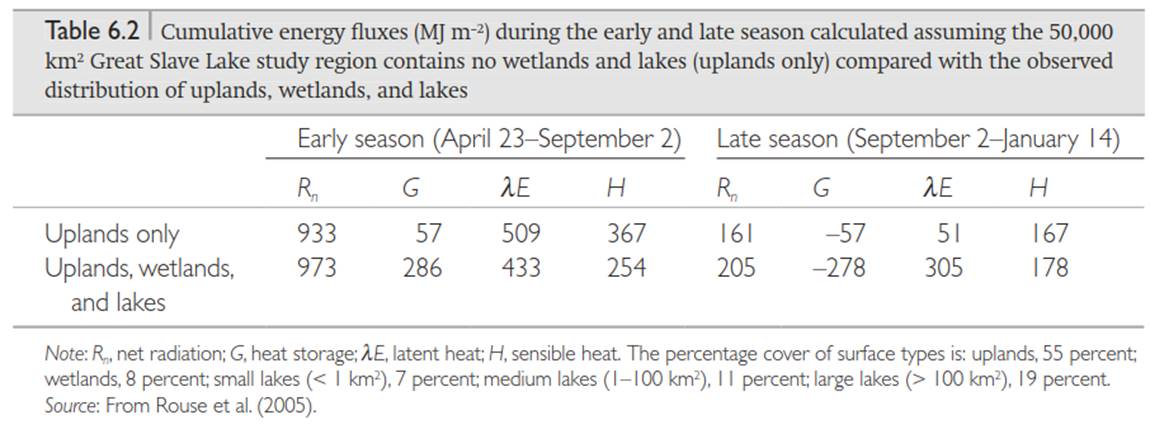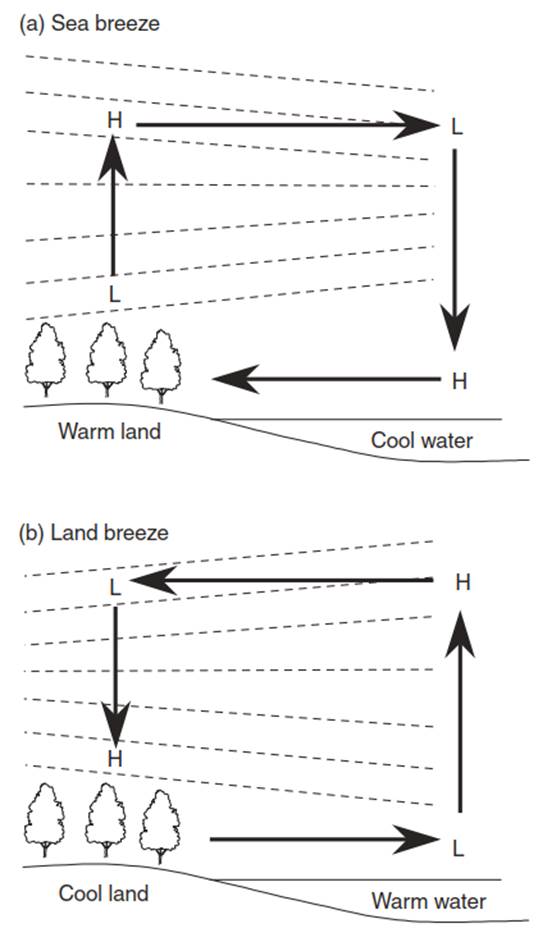How Lakes and Oceans Regulate Climate: Heat Storage, Temperature Moderation, and Weather Impacts
Lakes and oceans influence regional climate. In general, milder temperatures with smaller diurnal and seasonal temperature variability characterize seashore and lakeside climates compared with inland climates. Under the right conditions, the climatic effects of lakes and oceans extend far from shoreline. Simulations with a mesoscale climate model show the Great Lakes in North America warmed air temperature by 2°C as far away as Philadelphia, Pennsylvania, during a 2-day cold period in November 1982 (Sousounis and Fritsch 1994; Sousounis 1997,1998).
The climatic effects of water bodies arise from differences in surface radiation and heat capacity between water and land. Lakes and oceans, when ice-free, generally have a lower albedo than land and absorb more solar radiation. This solar radiation penetrates through the water to considerable depths so that it heats the upper 10 m or so of water rather than merely the surface. In addition, lakes and oceans have a large capacity to store heat. A typical heat capacity of soil is 2 MJ m-3 K-1 while that of water is 4.2 MJ m-3 K-1 (Table 9.1). In other words, a cubic meter of water requires twice as much energy to warm 1°C as does the same volume of soil. Conversely, it must lose twice as much energy to cool by 1°C. The large heat capacity of water reduces daytime warming and nighttime cooling compared with land. Likewise, the annual cycle of air temperature is moderated as heat is stored in water during summer and released in winter.
Studies of the energy balance of upland soil and small, medium, and large lakes in the Great Slave Lake region of Canada covering 50,000 km2 illustrate the contrast between land and water surfaces (Oswald and Rouse 2004; Rouse et al. 2005). Lakes cover 37 percent of the landscape; wetlands occupy an additional 8 percent of the region. Small, shallow lakes with an area less than 1 km2 generally thaw rapidly with the onset of air temperature above freezing. Albedo decreases as the snow and ice on the lake melts. Thereafter, solar heating warms the lake and evaporation commences. Autumn freeze-up occurs quickly and limits evaporation. Large, deep lakes with an area greater than 100 km2 have a much different energy balance. These lakes require longer periods to thaw and warm and remain unfrozen into late autumn or early winter. Ice breakup in Great Slave Lake typically occurs between late May and late June. Ice typically forms between late November and late December.
Energy fluxes vary considerably depending on the size of these lakes. Lakes accumulate more net radiation at the surface over the period April 23 to January 14 compared with uplands, largely due to the lower albedo of water compared with soil. Small, shallow lakes thaw earlier than larger, deeper lakes and therefore accumulate more net radiation earlier in the season. Lakes store considerably more heat than does soil. Large, deep lakes store more heat than do small, shallow lakes. Small lakes reach maximum heat storage earlier (August 1) compared with medium lakes (August 6) and large lakes (September 8). By late summer, one-quarter to three-quarters of net radiation has been used to heat lakes depending on lake size. Upland soils and small lakes have similar latent heat flux until mid-July, when dry soil limits evaporation.
The large heat storage of lakes sustains evaporation into autumn and winter. Small lakes evaporate through September. Evaporation from medium and large lakes begins later than uplands and small lakes. Medium lakes have evaporation rates comparable to small lakes, but extend into November. Evaporation rates are low in large lakes until mid-September, when evaporation increases. Evaporation extends into early January until the water is fully frozen. Evaporation extends over a 19-week season in uplands, 22 weeks in small lakes, 24 weeks in medium lakes, and 30 weeks in large lakes. Overall, the presence of lakes in this region increases net radiation at the surface compared with upland sites (Table 6.2). Maximum heat storage in the early season is increased by a factor of five. Evaporation decreases somewhat during the early season, but increases sixfold in the late season.

The heat stored in lakes is mixed vertically as a result of density differences in water. For freshwater, greatest density occurs at about 4°C. Water warmer than 4°C is less dense. Hence, cold, dense water sinks to the bottom of lakes while warm, light water rises to the surface. This is most evident in summer months, when temperate lakes are stratified into three distinct layers: an upper layer formed by warm, light water (the epilimnion); a transition zone in which temperature changes rapidly with depth (the thermocline); and a deep layer formed by cold, dense water (the hypolimnion). Towards the end of summer and into autumn, surface water cools and sinks to deeper depths. As the surface water mixes with deeper cold water, heat is distributed throughout the vertical profile in a process known as overturning, and the lake develops a uniform temperature profile from surface to bottom. Similar overturning occurs in spring, followed by surface warming and thermal stratification in summer.
In addition to modulating temperature, lakes and oceans can develop local atmospheric circulations. Land and sea breezes develop when the temperature contrast between land and water produces air pressure differences that result in surface breezes onshore during the day and offshore at night (Figure 6.17). During the day, land warms more than water. The air overlying land warms, and the warm surface air rises. The expansion of the air column over land means that pressure aloft is higher over land than over water. The horizontal pressure gradient causes winds aloft to blow offshore from land to water.

Fig. 6.17. Atmospheric circulation for (a) daytime sea breeze and (b) nighttime land breeze. The dashed lines are isobars of equal pressure. Miller et al. (2003) review sea breeze systems
The offshore flow aloft adds mass to the column of air over water, increasing the pressure at the ocean surface. Surface air flows from high pressure over ocean to the low pressure over land. The result is a local circulation system in which warm air rising over land is replaced with cool ocean air at the surface. These sea breezes generally develop by mid-morning on hot, sunny days with calm weather. At night, land cools more than water. The result is a system of descending air over land and rising air over water driven by offshore surface breezes. Similar breezes can develop for lakes of 200 km) or so (Sun et al. 1997) and for large rivers (Silva Dias et al. 2004).
Another influence of water bodies is the lake effect storms that dump heavy snowfall on the southern and eastern shores of the Great Lakes. Snowfall at lakeside may be twice as deep as inland sites. Lake effect snow develops when cold, dry arctic air moves over the warmer Great Lakes. The cold air is heated and moistened as it travels over the lakes. Heat and moisture make the air unstable. The warm, moist surface air rises, forming clouds that precipitate snow. In addition, the warmer, more humid air encounters a rough surface as it flows on shore. Winds slow and the convergence of air forces air upwards where it cools, condenses, and precipitates as snow.
Date added: 2025-05-15; views: 280;
